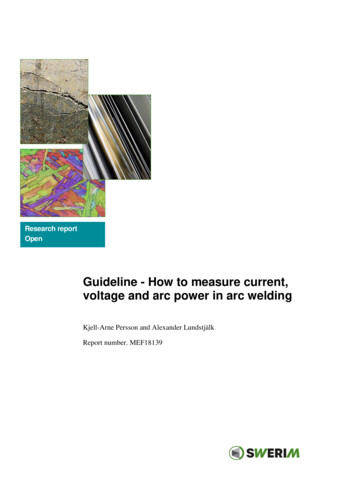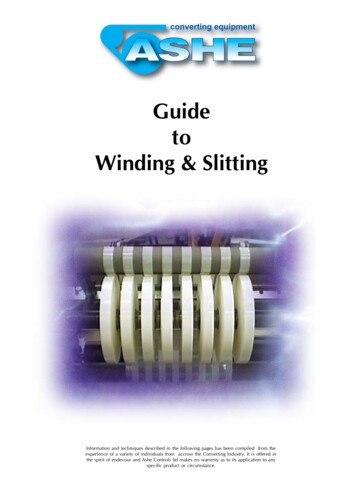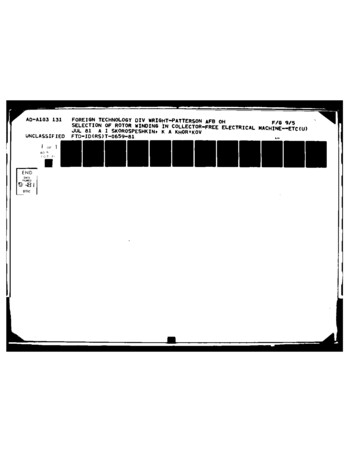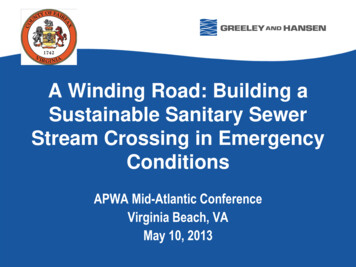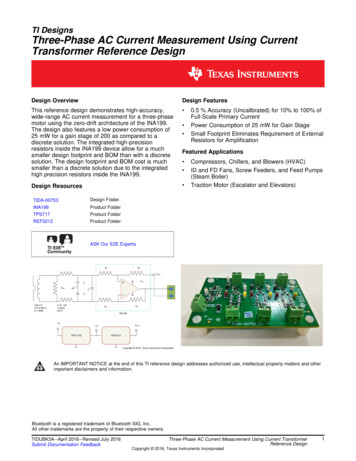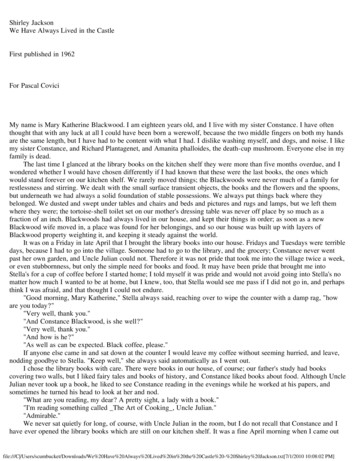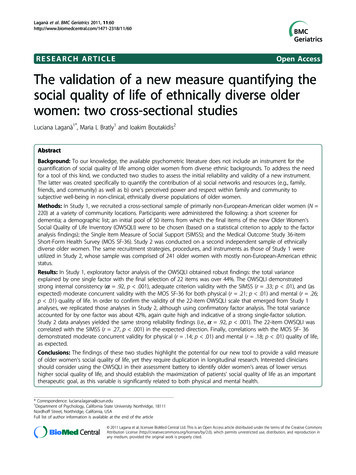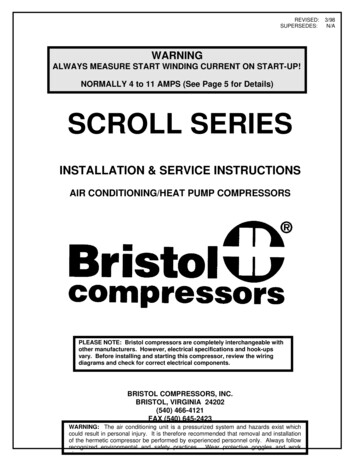
Transcription
REVISED:SUPERSEDES:WARNINGALWAYS MEASURE START WINDING CURRENT ON START-UP!NORMALLY 4 to 11 AMPS (See Page 5 for Details)SCROLL SERIESINSTALLATION & SERVICE INSTRUCTIONSAIR CONDITIONING/HEAT PUMP COMPRESSORSPLEASE NOTE: Bristol compressors are completely interchangeable withother manufacturers. However, electrical specifications and hook-upsvary. Before installing and starting this compressor, review the wiringdiagrams and check for correct electrical components.BRISTOL COMPRESSORS, INC.BRISTOL, VIRGINIA 24202(540) 466-4121FAX (540) 645-2423WARNING: The air conditioning unit is a pressurized system and hazards exist whichcould result in personal injury. It is therefore recommended that removal and installationof the hermetic compressor be performed by experienced personnel only. Always followrecognized environmental and safety practices. Wear protective goggles and workl3/98N/A
.WARNING: Never use oxygen to pressurize a refrigeration or air conditioning system.Oxygen can explode on contact with oil and could cause personal injury. When using highpressure gas such as nitrogen or CO2 for this purpose, be sure to use a regulator that cancontrol the pressure down to 1 or 2 psig.The following instructions are general but include major points of consideration that will ensure proper installation andprotect you from possible personal injury. Please use this as a checklist, taking each item in its order before proceedingto the next. If more information is required, please call Bristol Compressors Service Department.1.VERIFY PROPER APPLICATION. Verify that the compressor being replaced and the Bristol compressorhave a like capacity for the refrigerant being used and that the voltage and frequency characteristics arethe same. Consult your wholesaler if you have any questions about proper compressor application.WARNING:2.To avoid electrical shock, power to the compressor should remain off duringperformance of Steps 2 thru 9.DETERMINE CAUSE OF INITIAL FAILURE. Double check system and associated controls to make surecompressor replacement is necessary. In order to prevent a second failure, the cause of the originalfailure must be determined. Identify the cause and make the necessary repairs. This may requirethorough system monitoring after the replacement is installed and running.A.BEFORE REMOVING THE FAULTY COMPRESSOR: Remove refrigerant charge using properrecovery procedures. Bristol scrolls have no process tubes. Access to the system is normallyachieved at the suction or discharge service valve or the access fittings in the low and/or high side ofthe system. If the system does not have access fittings, they should be installed. Because of theBristol scrolls’ internal sealing ability, refrigerant must be recovered through both the high and lowside to avoid trapping refrigerant. Failure to do so could result in a hazardous condition if a torch isused to disconnect lines. Call 1-800-441-9450 for the name of the nearest Dupont authorizeddistributor, or 1-800-631-8138 for Genetron Representative or 1-800-ASK-KLEA (ICI) for informationon their refrigerant reclaim programs.B.Remove the electrical leads from the compressor. Note the terminal to which each wire is connected.C.During the next operation, the access ports should be open so that pressure does not build up in thesystem. If space permits, cut both the suction and discharge lines loose as close to compressor aspossible with tubing cutter. If sweating them loose is necessary, use a high temperature torch and beprepared to extinguish any remaining oil or refrigerant that may possibly ignite when lines aredisconnected.D.To assure excessive oil does not remain in the system, measure oil in failed compressor.Oil Charge Levels. Bristol Scroll compressors are charged with oil at the factory to the levelspecified on the code plate. For compressors using Refrigerant 22, the oil used is Zerol 150 with 3%Syn-O-Ad. If additional oil charge is added for in-service conditions, only Zerol 150 with Syn-O-Adshould be used. Oil levels can vary with different models and manufacturers. Refer to the individualmodel specification or consult your wholesaler to obtain this information.NOTE: If oil level is low, flush excess from system.CAUTION: The compressor may contain harmful acids be sure to handle with extreme care usingproper protection equipment. After confirming oil charge level, return oil to the compressor. Thesuction and discharge copper tube fittings should be securely plugged or brazed closed. This isneeded to prevent further contamination of the compressor and to prevent spillage from thecompressor.3.MOUNT THE NEW COMPRESSOR. Do not remove dust cover or rubber shipping plugs until all otherconnections have been completed (i.e., filters installed and all tubing changes made see steps 4 and 5).Compressor should not be open to the atmosphere for more than 15 minutes. Be sure to use the newPage 2
mounting grommets that were shipped with the compressor. If the mounting sleeves shipped with thecompressor are used, the mounting bolts will bottom out when tight. Use care not to over-compress themounting grommets when the mounting sleeves cannot be used.4.INSTALL FILTER DRIERS. Bristol Compressors recommends the use of adequately sized liquid andsuction line driers anytime a compressor is replaced. Assure the driers are compatible with the refrigerantused in the system. If the new compressor is used to replace a compressor with a burned motor, the useof a high acid neutralizing filter drier is recommended. For heat pumps, a suction filter drier must beinstalled between the accumulator and the compressor suction inlet. In addition, a bi-directionalheat pump liquid line drier or factory recommended driers must be installed. NOTE: ALWAYSREMOVE OLD FILTER DRIERS.5.BRAZE ON SUCTION AND DISCHARGE LINES. Flow an inert gas, such as nitrogen or CO2, through thesystem at approximately 2 psig. This will reduce the possibility of oxidation inside the tubing. Braze on thesuction and discharge lines.COPPER TUBING:If additional copper tubing is required, use only clean, dehydrated refrigerationgrade tubing with sealed ends. If a major change in tubing configuration ismade, the original system’s sound and vibration characteristics may be altered.Attention must be given to vibration, pressure drop, and interference.BRAZING ALLOYS:CAUTION: Do not use 95/5, 50/50 or 40/60 soft solder for brazing. Use Sil-Fos orPhos Copper, or similar brazing alloys with high tensile strength on copperwelds only. Weld steel to copper only with silver brazing alloys.BRAZING PROCEDURE: To ensure properly brazed joints, Bristol Compressors recommends that thefollowing procedure be used:Do not bend the discharge or suction lines or force the unit piping into thecompressor connections since this will increase stress and potential for failure.Tube Brazing1. Recommended brazing material: A 15% silver brazing material isrecommended for copper plated steel suction and discharge fittings.2. Clean the compressor tubing and system piping prior to assembly.3. A double-tipped torch is recommended during brazing.a. Apply heat to Area 1, moving the torch up and down and rotatingaround the tube in order to heat the tube evenly. It will become a dullorange color.b. Move the torch to Area 2 until it reaches a dull orange color. Move thetorch up and down and rotate it around tube in order to heat the tubeevenly.c.Add braze material to the joint while moving the torch around joint toflow braze material evenly around the circumference.Page 3
d. After braze material flows around the joint, move torch to Area 3. Thiswill draw the braze material into the joint. The time spent heating Area3 should be minimal in order to keep excess braze material fromentering the compressor.6.CHECK SYSTEM FOR LEAKS. After installation is complete, pressurize the system to 75 psig usingnitrogen and a few ounces of system refrigerant. Check for leaks using a halide torch, soap bubbles or anelectronic halogen leak detector. When all connections test satisfactorily, release pressure using properrecovery procedures, then proceed to next step.CAUTION: Do not use the Bristol replacement compressor as an evacuation assist and neverapply voltage to a compressor while it is in a vacuum as damage could result to thecompressor.7.EVACUATE THE SYSTEM. Use a vacuum pump designed for this purpose. Vacuum must be pulled onthe discharge (high side) and suction (low side) of the system. Evacuate to 200 microns or lower.8.CHECK THE ELECTRICAL SYSTEM. While the system is evacuating, connect the electrical leads to thecompressor terminals. If the ground wiring terminal is utilized, refer to page 9 or the recommended threadcutting screw. Verify that the electrical system is wired according to the unit's manufacturer and Bristol'swiring diagram on page 8. Verify that the electrical components match those specified on the compressorelectrical data sheet on page 9. It's a normal practice to replace all starting components any time acompressor is changed. Check all connections and terminals to be sure they are tight. Bristol scrollcompressors do not require a crankcase heater. However, if desired, a wrap around heater can be used(see page 9). If applied, assure correct operational voltage to the heater and wire to be energizedcontinuously.WARNING: Voltage should not be applied to the compressor with the terminal cover removed aspersonal injury could result.Power Terminal Connections for Bristol ScrollT1(C)T2(S)T3(R)Compressor Power TerminalDiagram (Push-on)9.Compressor Power Terminal(Ring) - T-BlockCHARGE THE SYSTEM. When a vacuum of at least 200 microns is reached, close gauge valve, removevacuum pump, and break the vacuum using system refrigerant vapor. Never dump liquid refrigerant intothe compressor. Liquid can be used to break the vacuum if it is connected to the liquid line, not thedischarge line.Charge the system according to the manufacturer's specifications. Be sure to compensate the charge forthe addition of the filter drier. The preferred superheat should be 18-20 F at the compressor on a systemwith a TXV, see Step 11.Page 4
WEIGHING in the system charge to the factory specification will help point out system faults thatmay still exist.10.START UP. CLAMP-ON AMMETER MUST BE IN PLACE BEFORE POWER IS APPLIED TO MONITORSTART WINDING CURRENT ON START-UP!! See belowASSURE THESE NORMAL START WINDING CURRENTS ON START-UPCONDITIONAPPROX. CURRENTNORMAL START WITH RUN CAP ONLY4 - 11 AMPSNORMAL START WITH RUN AND START CAP20 AMPS AND DROP TO 4-11 AFTER STARTWARNING: If above currents are exceeded for more than 5 seconds, disconnect power andcorrect the fault before restarting.NOTE: Assure voltage to compressor does not drop below minimum allowable voltage (eg. 197volts for 230/208-1-60) during the period the compressor is trying to start.FOR CAPACITOR START/CAPACITOR RUN (CSR) MODELSPUT YOUR CLAMP-ON AMMETER IEDTERMINALTO LINE SIDESTARTCAPACITORPage 55AMPS SHOULD DROP TO"O" AFTER STARTBLEEDRESISTOR
ASSURE CORRECT ROTATION. Bristol scroll compressors are designed to operate in one specificrotational direction. Reverse rotation can result in compressor damage and the following steps should betaken to minimize exposure to this condition.THREE PHASE motors will start and run in either direction depending on the phase relationship of thesupplied power. This requires special attention at start-up and the use of “phase monitors” to insure thecompressor is phased for proper rotation. Verification of proper rotation may be accomplished byobserving system pressures when the compressor is energized. Reverse rotation is indicated by adecrease in discharge pressure and an increase in suction pressure and possible noisy operation. Ifimproper rotation is allowed to continue, the compressor internal line break overload will shut thecompressor off. To correct the rotation, disconnect power and switch any two power leads at the unitcontactor. Never switch leads directly at the compressor.SINGLE PHASE (PSC) motors normally start and run in the correct direction and reverse rotation isgenerally not a concern. However, Bristol single phase scrolls may be forced into reverse direction, ifsubjected to a brief power interruption. At the initial interruption of power to the Bristol scroll, some of thehigh pressure refrigerant will flow back through the scrolls and cause the motor to rotate in the reversedirection. If, during this brief period of reverse rotation, power is re-applied, the compressor can operateunder power in a reverse direction. An internal check valve is employed to minimize the possibility of thisoccurring. As with the three phase, reverse operation is indicated by noisy operation, a decrease indischarge pressure and an increase in suction pressure. If reverse operation continues, the compressorinternal line break overload will shut the compressor off and when it resets, the compressor will start andoperate in the correct direction.To avoid reverse operation of the Bristol single phase scroll, a two minute off-cycle time delay relay (delayon break) should be installed in the control circuit. The time delay must be sensitive to momentary powerinterruptions. See diagram below.CONTROLSUPPLYVOLTAGEFUSE2 C1CONDENSER FANCONTACTOR11.WORST CASE CONDITION CHECKS.HEAT PUMPSTEP 1: Operate system in the heating mode with outdoor fan disconnected.STEP 2: Run system until the designed winter condition in your area is reached (may need to cover coilfor this test).STEP 3: Check suction superheat 6" from compressor inlet.STEP 4: Superheat should not drop below 5 F (prefer no lower than 10 F).Page 6
STEP 5: Sump temperature should always be 50 F or higher above saturated suction temperature.EXAMPLE: "R-22"38 psig 16 F SATURATED SUCTION 50 F MINIMUM TEMP. DIFFERENCE66 F MINIMUM SUMP TEMPERATURECOOLI
distributor, or 1-800-631-8138 for Genetron Representative or 1-800-ASK-KLEA (ICI) for information on their refrigerant reclaim programs. B. Remove the electrical leads from the compressor. Note the terminal to which each wire is connected. C. During the next operation, the access ports should be open so that pressure does not build up in the system. If space permits, cut both the suction and .
